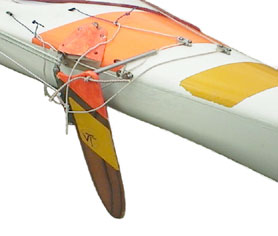mick_allen
Paddler & Moderator
- Joined
- May 15, 2005
- Messages
- 3,585
Not in this thread, we love to see the various alternatives – especially well thought out ones.My first post to WPC and it's about rudders! That's potentially an unwise move
It is so very interesting that both you and Sandy have very serious rudders. They don’t have the spit and polish of manufactured rudders but their beauty lies in the great thought and engineering that you both have put into them:
Turning to your rudder specifically the points that I note about it are:
- It is a ‘transom hung’ rudder that has a long and substantial housing hinge that encompasses the full height of the ‘transom’
- The housing drops almost to the water level and supports and stabilizes the blade to the maximum but just stops short of causing drag.
- A partial concealing slot into the deck that the rudder must be aligned with by feel [or experience] to reduce windage, provide strength on the beach or in transit, and possible provide a little less obstruction.
- Substantial construction.
I’m surprised you expose the retracting lines while hiding the rudder lines, but very interesting that you cross those rudder lines – I bet only a few percent of paddlers do that. It’s counterintuitive to traditional aeronautical rudder pedal orientation, but not to foot bracing and lean for kayaks. Did it take you long to get used to it or did you always do that? [ I would always keep it traditional to not get confused and I think the gas pedal bracing means there’s little detriment- but just a thought]
The transom [or more exactly stem or ‘frame’] hung rudder was its greatest advance because of the great strength and protection provided by that member. Historically the blade base was aligned or slightly above the keel for that protection, but keeping the housing just above water level and having a rotating blade allows similar safety as it can move out of the way and the highish housing is well protected - more than a traditional. Taking full advantage of the height of that stem/transom for both strength and housing stability just makes full sense.
Of course there are a bunch of these out there by manufacturers and even another [only] slightly misguided by one of your fellows in NZ:
The VCP C-trim shows an inset similar to yours [JKA's rudder] but the others show the basic qualities of transom hungs and extended housings to a varied degree. Those rudders basically get it: good transom connection, similar sized housing to rudder blade head size and a housing that extends to some degree depending on the rudder. More would be better in some cases.
But essentially the designer(s) comprehends the issues and advantages that this approach allows . . .
**
But have a look at the following transom hung rudders. I won’t name any names, but this first one demonstrates that the designer has absolutely no idea of what the issues are or how to respond to them. But look at the nice clean materials and the nice curves and shapes that make up its form:
How can one say that JKA’s roughish rudder is beautiful in comparison to the above well rendered rudder example? What aspects of a transom hung rudder are missed here to the point of being simply ludicrous? Does function have beauty over form? Can form be ugly?
So that’s an unnamed recreational kayak, but what excuse does a well-known and respected sea and whitewater kayak company have for doing essentially the same thing with this example of misunderstanding the beneficial aspects of this approach:
Now good transom hung rudders have their drawbacks just like any other good rudder has: the simplest is there needs to be a transom [or a verticallish stem in our case]! And for the kayak to be well designed for these, it needs to be of the type that has a ‘transom’ – and not some blobbed on extension or extrusion or hacked off mistake that completely negates the original lines of that particular kayak.
Last edited:


 Excuse the pun.
Excuse the pun.

